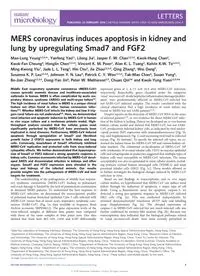
2016 MERS coronavirus induces apoptosis in kidney and lung by upregulating Smad7 and FGF2 PDF
Preview 2016 MERS coronavirus induces apoptosis in kidney and lung by upregulating Smad7 and FGF2
MERS coronavirus induces apoptosis in kidney and lung by upregulating Smad7 and FGF2 Man-Lung Yeung1,2,3,4†, Yanfeng Yao5†, Lilong Jia2, Jasper F. W. Chan1,2,3,4, Kwok-Hung Chan2, Kwok-Fan Cheung6, Honglin Chen1,2,3,4, Vincent K. M. Poon2, Alan K. L. Tsang2, Kelvin K.W. To1,2,3,4, Ming-Kwong Yiu7, Jade L. L. Teng2, Hin Chu2, Jie Zhou1,2,3,4, Qing Zhang6, Wei Deng5, Susanna K. P. Lau1,2,3,4, Johnson Y. N. Lau4, Patrick C. Y. Woo1,2,3,4, Tak-Mao Chan6, Susan Yung6, Bo-Jian Zheng1,2,3,4, Dong-Yan Jin8, Peter W. Mathieson6,9, Chuan Qin5* and Kwok-Yung Yuen1,2,3,4* Middle East respiratory syndrome coronavirus (MERS-CoV) causes sporadic zoonotic disease and healthcare-associated outbreaks in human. MERS is often complicated by acute res- piratory distress syndrome (ARDS) and multi-organ failure1,2. The high incidence of renal failure in MERS is a unique clinical feature not often found in other human coronavirus infec- tions3,4. Whether MERS-CoV infects the kidney and how it trig- gers renal failure are not understood5,6. Here, we demonstrated renal infection and apoptotic induction by MERS-CoV in human ex vivo organ culture and a nonhuman primate model. High- throughput analysis revealed that the cellular genes most significantly perturbed by MERS-CoV have previously been implicated in renal diseases. Furthermore, MERS-CoV induced apoptosis through upregulation of Smad7 and fibroblast growth factor 2 (FGF2) expression in both kidney and lung cells. Conversely, knockdown of Smad7 effectively inhibited MERS-CoV replication and protected cells from virus-induced cytopathic effects. We further demonstrated that hyperexpres- sion of Smad7 or FGF2 induced a strong apoptotic response in kidney cells. Common marmosets infected by MERS-CoV devel- oped ARDS and disseminated infection in kidneys and other organs. Smad7 and FGF2 expression were elevated in the lungs and kidneys of the infected animals. Our results provide insights into the pathogenesis of MERS-CoV and host targets for treatment. The understanding of the pathogenesis of Middle East respirat- ory syndrome coronavirus (MERS-CoV) leading to pulmonary and renal damage is limited by the lack of postmortem examination in deceased MERS patients. To understand the host response to MERS-CoV infection, we determined the transcriptomic profiles of polarized human bronchial epithelial Calu-3 cells infected with MERS-CoV versus that of severe acute respiratory syndrome coro- navirus (SARS-CoV) (Fig. 1a; data available at Sequence Read Archive accession, SRP056612). The gene expression levels of the virus-infected samples at different time points were compared with those of the same samples at time point zero. Our data showed that there were 462, 639, 1,650 and 4,287 differentially expressed genes at 2, 4, 12 and 24 h after MERS-CoV infection, respectively. Remarkably, genes classified under the categories ‘renal necrosis/cell death/nephritis/inflammation/damage/prolifer- ation’ were predominantly affected in MERS-CoV-infected but not SARS-CoV-infected samples. The results correlated with the clinical observation that a high incidence of renal failure was found in MERS but not SARS patients3,7,8. Despite reports on the detection of MERS-CoV RNA in the urine of infected patients9,10, in vivo evidence for direct MERS-CoV infec- tion of the kidney is lacking. Hence, we developed an ex vivo human kidney culture model and showed that MERS-CoV, but not SARS- CoV, productively infected kidney cells, as indicated by viral nucleo- capsid protein (NP) expression with immunofluorescence (Fig. 1b, top, and Supplementary Fig. 1) and increasing viral load in collected tissues (Fig. 1b, bottom). To specify the infected cell types, we co- stained the kidney tissue for MERS-CoV NP and various kidney cel- lular markers. The substantial co-localization of MERS-CoV NP with cytokeratin 18 in renal tubular cells, CD31 in vascular epithelial cells and synaptopodin in podocytes suggested that multiple types of kidney cells were susceptible to MERS-CoV infection. The tissue susceptibility was also recapitulated in renal cellular models, includ- ing primary normal human mesangial cells (NHMCs) and renal proximal tubular cells (HK2) (Fig. 1c). These models allowed us to further investigate the biological changes induced by MERS-CoV infection in vitro. Based on our findings in transcriptomic and ex vivo organ culture studies, we hypothesized that MERS-CoV can induce renal failure through the induction of apoptosis, a major type of cell death. Using a fluorometric assay for apoptotic caspase-3, we detected a strong pro-apoptotic response in MERS-CoV-infected HK2 cells (Fig. 2a). This was confirmed independently by terminal deoxynucleotidyl transferase dUTP nick end labelling assay (Supplementary Fig. 2a). The elevated expression of caspase-3 in MERS-CoV-infected but not mock-infected cells was further confirmed by western blot analysis (Fig. 2b). Because our transcriptomic data indicated that the biological pathways related to ‘renal necrosis/cell death’ were most severely perturbed in 1State Key Laboratory of Emerging Infectious Diseases, The University of Hong Kong, Hong Kong Special Administrative Region, Hong Kong, China. 2Department of Microbiology, The University of Hong Kong, Hong Kong Special Administrative Region, Hong Kong, China. 3Research Centre of Infection and Immunology, The University of Hong Kong, Hong Kong Special Administrative Region, Hong Kong, China. 4Carol Yu Centre for Infection, The University of Hong Kong, Hong Kong Special Administrative Region, Hong Kong, China. 5Institute of Laboratory Animal Sciences, Chinese Academy of Medical Sciences, Chaoyang District, Beijing, 100021, China. 6Department of Medicine, The University of Hong Kong, Hong Kong Special Administrative Region, Hong Kong, China. 7Department of Surgery, The University of Hong Kong, Hong Kong Special Administrative Region, Hong Kong, China. 8Department of Biochemistry, The University of Hong Kong, Hong Kong Special Administrative Region, Hong Kong, China. 9President’s Office, The University of Hong Kong, Hong Kong Special Administrative Region, Hong Kong, China. †These authors contributed equally to this work. *e-mail:
